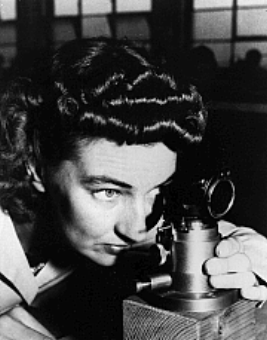




Many women undertook optical munitions work coordinated through the the Optical Munitions Panel. As Australian men rushed to enlist in the armed services, laboratories and factories became desperate for workers, and women were only too glad to help out. The women workers came from many walks of life: teenagers just out of school, laboratory assistants, secretaries, politician and land-owners' daughters - even T.H. Laby's daughter, Eudora, became involved in the work of the Panel.
The women carried out a variety of tasks. Many were 'calculators', in a way this was similar to being a human computer. Calculators did all the mathematical calculations involved with lens design by hand, with just desk calculators to help them! The Commonwealth Solar Observatory had a room full of women calculators; located near the present-day Library, it was known as the Hen House!
All the universities and government laboratories involved in optical munitions work also employed women workers for the duration of the war. Many women became technical assistants, carrying out tasks such as:
It is interesting to note that the equal pay for equal work case of the female optical workers was the first to be heard by the Women's Employment Board in Canberra. F. Lord, who worked closely with the women, felt that the work of men and women was 'interchangeable'. Although, at the hearing, R. v.d.R. Woolley explained that while the women did the same work as their male counterparts at the CSO, he felt that 'in all cases the best males were superior to the best females'!(1) Nevertheless, the women were granted a major pay rise.
In Tasmania, women were involved in optical munitions work at the Waterworth Hobart Annexe.
I think McAulay first of all brought in one or two of the secretaries from the university itself. Every woman in sight was only too happy to jump in and do work of that sort ... All the friends of McAulay and me and Cruickshank, women friends, others, were all brought in straight away. That provided the nucleus within a matter of the first few weeks. Then they began to take on greater numbers from the general public. All the Physics lecture rooms and laboratories had polishing spindles in them.- Eric Waterworth(2)
Women contributed much to the wartime industries and filled an important role in supporting the war effort, while their husbands and sons were away fighting on the various war fronts. Many women remember it with great satisfaction; a time of friendships, responsibility, hard work and freedom. Val Pearce, from Hobart, was one of the many who went straight from school to work in optical munitions:
While I was still at school and [in] my first years at Matric, Professor McAulay came down to the school at Fahan to recruit. I didn't know what I wanted to do after I left school, so I finished school. No school holidays. I went straight in, even before Christmas ... I went straight there along with a couple of other girls from school. There were only five or six there when we went. We were just in one small room in the university down by the Domain ...I can remember the noise, the singing and the chatter that always went on. We always had the wireless blaring with all the pop songs at the time, and it was a very happy atmosphere. We really did have a lot of fun. (3)
(1) Canberra Times, 28 November 1944, p. 3.
(2) Interview with Eric Waterworth, in Jill Cassidy (1990), Eric Waterworth: an inventive Tasmanian, Exhibition Catalogue, Queen Victoria Museum and Art Gallery, Launceston, p. 9.
(3) Interview with Val Pearce, in Jill Cassidy (1990), Eric Waterworth: an inventive Tasmanian, Exhibition Catalogue, Queen Victoria Museum and Art Gallery, Launceston, pp. 9 and 14.








 Top |
Bright SPARCS |
ASAPWeb
Top |
Bright SPARCS |
ASAPWeb
